Balbharti Maharashtra State Board Class 8 History Solutions Chapter 11 Struggle for Equality Notes, Textbook Exercise Important Questions and Answers.
Maharashtra State Board Class 8 History Solutions Chapter 11 Struggle for Equality
Class 8 History Chapter 11 Struggle for Equality Textbook Questions and Answers
1. Rewrite the statements by- choosing the appropriate options:
(Lala Lajpat Rai, Sane Guruji, Dr. Rakhmabai Janardan Save, Deenbandhu Mitra, Babasaheb Bole)
Question 1.
…………….. founded the Red Cross Society at Rajkot.
Answer:
Dr. Rakhmabai Janardan Save
Question 2.
…………….. was the president of mill workers union at Ammalner.
Answer:
Sane Guruji
Question 3.
The president of the first session of AITUC was ……………..
Answer:
Lala Lajpat Rai
2. Write short notes:
Question 1.
Social Work of Maharshi Vitthal Ramji Shinde :
Answer:
- The goal of Maharshi Vitthal Ramji Shinde was to make the Dalits self respectful, well educated and engaged in work.
- He worked to destroy the delusive ideas regarding Dalits in the minds of the upper caste.
- He founded the ‘Depressed Classes Mission’ for the progress of Dalits in 1906.
- To achieve this, he started Marathi schools and work schools in parts of Parel, Deonar in Mumbai.
- He actively took part in various movement which were related to the welfare of the Dalits like Satyagraha for entry in Parvati temple at Pune, Shetkari Parishad of Dalits and Federal Electorates.
![]()
Question 2.
Reforms of Rajarshi Shahu Maharaj in the state of Kolhapur :
Answer:
- Rajarshi Shahu Maharaj worked for abolishing of caste discrimination.
- He made revolutionary declaration for reservation in the state of Kolhapur.
- He made law for free and compulsory primary education.
- He worked to remove restrictions on inter dining, intermarriage and change of occupation in the caste system.
- He passed the Act of inter-caste marriage and made it legal in state.
- He abolished ‘Balutedari System’, by publishing a declaration in the Government Gazette of the state of Kolhapur on 22 February, 1918.
- This allowed people to practice any occupation and freed them from type of social slavery.
3. Explain the following statements with reasons:
Question 1.
The Government decided to crush down the Communist movement.
Answer:
- The Communist Party was formed in India in 1925.
- The young communist leaders started building militant organisations of workers and peasants.
- The British government started feeling the danger of Communist movement and hence decide to crush it.
Question 2.
Dr. Babasaheb Ambedkar started newspapers like ‘Muknayak’, ‘Bahishkrut Bharat’, etc.
Answer:
- Dr. Babasaheb Ambedkar wanted to establish a society based on principles of Liberty, Equality and Fraternity.
- He intended to carry out movement to establish self-respect and social equality for Dalits.
- It was necessary to create awakening in society in this respect and to voice their grief.
- The newspaper was an integral part of Dr. Babasaheb Ambedkar’s movement.
- Hence, he started many newspapers so that his ideas and thoughts reach the society.
![]()
Question 3.
There aroused a need of a nationwide workers union.
Answer:
- In the later half of the 19th century, textile mills, railway companies and such other industries were started in India.
- The workers group were not aroused on large scale.
- As there were no unions, the workers were not organised.
- After the First World War, there was rise of worker class in India due to industrialisation.
Therefore, a necessity was felt for a nationwide worker union.
4. Answer the following questions in brief:
Question 1.
Why was the struggle for equality important in the making of Modern India?
Answer:
- India achieved freedom because of freedom struggle.
- The scope of this struggle was not limited to achieve political freedom but emancipation of man from all types of bondages.
- Therefore in the course of this struggle, there was opposition to feudalism, social inequality and economic exploitation.
- The principle of equality was given equal importance.
- Various groups such as farmers, workers, women and Dalits came forward and started movements in order to get justice and bring about reforms.
This proves that the struggle for equality has great significance in the making of Modern India.
Question 2.
Write about the work of Sane Guruji in eastern Khandesh.
Answer:
- In 1938, due to heavy rains crops were destroyed in eastern Khandesh.
- He organised the farmers who were in miserable state.
- Sane Guruji organised meetings and processions at many places in eastern Khandesh to have land revenue waived for the farmers.
- He took out marches on the Collector office.
- He tried to create a strong centre of workers union at Dhule-Ammalner.
![]()
Question 3.
How was the struggle built up by the workers decisive for the national movement?
Answer:
- The beginning of the 19th century witnessed the emergence of working-class due to industrialisation. They made efforts to solve their problems.
- During the anti-partition movement, workers carried out strikes from time to time to pressurise the British government.
- The tea plantation workers in Assam launched an agitation against their wretched condition.
- During the anti-partition movement, workers carried out strikes from time to time in support of Swadeshi.
- In 1928, the Mill Workers Union went on strike for six months. Many such strikes were organised by the Railway workers, jute mill workers, etc.
Question 4.
Discuss the nature of reform movement related to women.
Answer:
- Women had a secondary position in the Indian social system.
- They were subjected to many injustices because of evil practices.
- In the 20th century, many reforms were initiated for the betterment of women.
- The reform movement was led by women and institutions formed by them.
- They fought for issues such as the right to inheritance, right to vote through the medium of these institutions.
- The involvement of women went on increasing. They played an active role in the national movement and in the revolutionary movement.
- Due to the reform movement, women were included in the Provincial Ministries.
Do you Know?
Narayan Meghaji Lokhande:
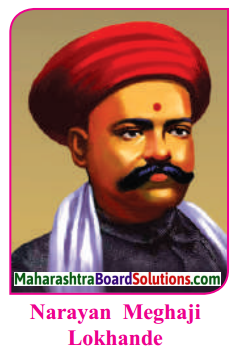
The native place of Narayan Meghaji Lokhande was Kanhesar near Saswad in Pune district.
- He formed the mill workers un ion known as ‘Bombay Mill Hands Association’ in 1890.
- This workers union is believed to be the beginning of organised movement in India.
- He was also the chairman of Mumbai branch of Satyashodhak Samaj founded by Mahatma Phule.
- Due to his efforts, from 10 June 1890, the workers started getting weekly holiday on Sunday.
![]()
Dr. Anandibai Joshi:
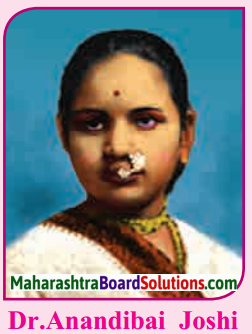
- She was the first Indian Female Doctor.
- The death of her 10 days old son inspired her to study medicine and acquired M. D. degree in 1886.
- She died of tuberculosis on February 1887 at Pune.
Project:
Question 1.
Read the biography of Dr. Anandibai Joshi.
Question 2.
Read the biography of Rajarshi Shahu Maharaj.
Class 8 History Chapter 11 Struggle for Equality Additional Important Questions and Answers
Rewrite the statements by- choosing the appropriate options :
Question 1.
……………. got a bill passed in the Bombay Provincial Assembly for the public water reservoirs to be opened to the untouchable.
Answer:
Babasaheb Bole
Question 2.
Neel Darpan written by …………….. brought to notice of the society wretched conditions of the peasants.
Answer:
Deenbandhu Mitra.
Name the following:
Question 1.
Through the magazine ‘Somavanshiya Mitra’ raised voice regarding issues of Muralis and Jogtins.
Answer:
Shivram Janbci Kamble
Question 2.
Chairman of Mumbai branch of Satyashodhak Samaj.
Answer:
Narayan Meghaji Lokhande
Question 3.
Movement of eradication of untouchability in Tamil Nadu
Answer:
Perriyar Ramaswamy
Question 4.
Active in international Communist Movement.
Answer:
Manavendranath Roy
![]()
Question 5.
Baba Ramachandra.
Answer:
Baba Ramchandra.
Rewrite the statements by choosing the appropriate options:
Question 1.
…………….. was the president of ‘Akhil Bharatiya Kisan Sabha’
(a) Sane Guruji
(b) Swami Sahajananda Saraswati
(c) Maharshi Vitthal Ramji Shinde
(d) Manavendranath Roy
Answer:
(b) Swami Sahajananda Saraswati
Question 2.
The session of the Congress was held in the rural part of …………… in Maharashtra.
(a) Nagpur
(b) Baramati
(c) Faizpur
(d) Miraj
Answer:
(c) Faizpur
Question 3.
……………… went on fast unto death to open the doors of Vitthal temple at Pandharpur for the Dalits,
(a) Sane Guruji
(b) Dr. Babasaheb Ambedkar
(c) Karmaveer Dadasaheb Gaikwad
(d) Babasaheb Bole
Answer:
(a) Sane Guruji
![]()
Question 4.
Due to efforts of …………….., the workers started getting weekly holiday on Sunday from 10 June, 1890.
(a) Shripad Amrut Dange
(b) Shashipad Banerjee
(c) Lala Lajpat Rai
(d) Narayan Meghaji Lokhande
Answer:
(d) Narayan Meghaji Lokhande
Question 5.
In 1881, …………….. wrote an article on Marx.
(a) Dr. Rammanohar Lohia
(b) Lokmanya Tilak
(c) Mahatma Gandhi
(d) Shripad Amrut Dange
Answer:
(b) Lokmanya Tilak
Question 6.
Condemned untouchability through his book ‘Vital Vidhwansan’
(a) Gopal Baba Walangkar
(b) Shivram Janba Kamble
(c) Thakkar Bappa
(d) Appasaheb Patwardhan
Answer:
(a) Gopal Baba Walangkar
Question 7.
Karmaveer Dadasaheb Gaikwad led Satyagraha for entry of Dalits in
(a) Kalaram temple
(b) Vitthal temple
(c) Parvati temple
(d) Bhavani temple
Answer:
(a) Kalaram temple
![]()
Question 8.
…………….. passed the Act of inter-caste marriage and gave it a legal acceptance in the state of Kolhapur.
(a) Mahatma Jyotirao Phule
(b) Rajarshi Shahu Maharaj
(c) Rajaram Maharaj
(d) Maharshi Vitthal Ramji Shinde
Answer:
(b) Rajarshi Shahu Maharaj
Answer the following questions in one sentence:
Question 1.
State the significance of ‘Neel Darpan’
Answer:
Deenbandhu Mitra in his play ‘Neel Darpan’ brought to the notice of the society the wretched conditions of the peasants who were forced to cultivate indigo.
Question 2.
What was the important work done by ‘Akhil Bharatiya Kisan Sabha’?
Answer:
The Akhil Bharatiya Kisan Sabha’ presented a declaration of peasants’ rights to the Indian National Congress.
Question 3.
What message did Lala Lajpat Rai give to the workers in the first session of AITUC?
Answer:
At the first session of AITUC Lala Lajpat Rai asked the workers to actively participate in the national movement.
Question 4.
Why did Dr. Ambedkar and his followers embrace Buddhism?
Answer:
Dr. Ambedkar and his followers embraced Buddhism as it advocated humanity and equality. ‘
Question 5.
Which institutions were founded by Pandita Ramabai?
Answer:
Pandita Ramabai had founded the ‘Arya Mahila Samaj’ and ‘Sharda Sadan’.
![]()
Question 6.
What message did Dr. Babasaheb Ambedkar give his followers?
Answer:
Dr. Babasaheb Ambedkar gave the inspirational message,’Be Educated, Be Organised and Be Agitated’ to his followers.
Do as Directed:
Complete the Concept Map:
Question 1.
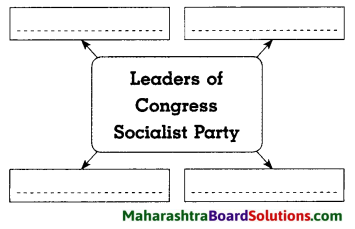
Answer:

Question 2.
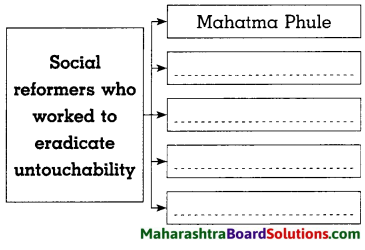
Answer:
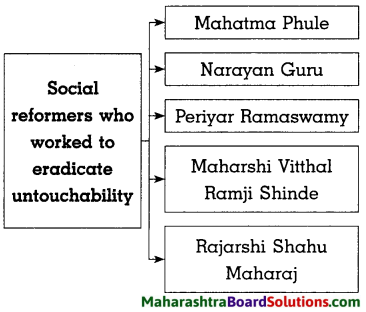
Question 3.
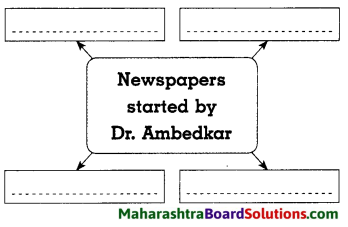
Answer:
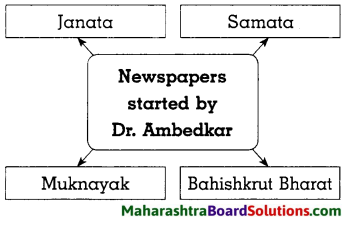
Complete the following table:
Question 1.
| Founder | Organisation/ Institution |
| 1. Maharshi Vitthal Ramji Shinde | ………………………………………… |
| 2. ………………………………. | Akhil Bharatiya Kisan Sabha |
| 3. Ramabai Ranade | ………………………………………… |
| 4. ……………………………….. | Independent Labour Party |
Answer:
| Founder | Organisation/ Institution |
| 1. Maharshi Vitthal Ramji Shinde | Depressed Classes Mission |
| 2. Prof. N.G. Ranga | Akhil Bharatiya Kisan Sabha |
| 3. Ramabai Ranade | Seva Sadan institution |
| 4. Dr. Babasaheb Ambedkar | Independent Labour Party |
Write short notes:
Question 1.
The Meerut Conspiracy Case:
Answer:
- The young communist leaders built militant organisations of workers and peasants.
- The growing influence of Communism on Indian youth became a matter of concern for the British and they felt it was a danger.
- The communist leaders Shripad Amrut Dange, Muzaffar Ahmed, Keshav Neelkanth Joglekar, etc. were arrested.
- They were falsely charged with planning of a conspiracy to overthrow the British rule.
- The trial took place at Meerut. So it was called as ‘Meerut Conspiracy Case’.
- They were given different punishments.
![]()
Question 2.
Work of Rakhmabai Janardan Save:
Answer:
- Dr. Rakhmabai Janardhan Save was the first practicing woman doctor in India.
- She delivered lectures on health related issues of women.
- She opened a branch of Red Cross Society at Rajkot.
Explain the following statements with reasons:
Question 1.
Narayan Meghaji Lokhande is described as ‘Father of Indian Workers Movement’.
Answer:
- Industrialisation of India had started during the second half of the 19th century.
- Shashipad Banerjee and Narayan Meghaji Lokhande organised workers at local level and made efforts to solve their problems.
- Narayan Meghaji Lokhande formed the mill workers union known as ‘Bombay Mill Hands Association’ in 1890.
- Due to his efforts, the workers started getting weekly holiday on Sunday from 10 June, 1890.
- This was the beginning of organised movement in India.
Thus, his contribution to the working-class movement was so valuable that he is described as ‘Father of Indian Workers Movement’.
Question 2.
The Congress Socialist Party was formed in 1934.
Answer:
- Many young activists of the Indian National Congress believed that the society should be built on the principles of economic and social equality.
- Due to this, there was spread of socialist ideas and thoughts.
- They believed that to protect interests of the people it was necessary to overthrow the British rule.
- So, they decided to set up a Socialist Party within the Congress fold while they were in Nashik jail. Accordingly, the Congress Socialist Party was formed in 1934.
Answer the following questions in brief:
Question 1.
Write about the work of Rajarshi Shahu Maharaj for abolition of caste distinction.
Answer:
The following work was done by Rajarshi Shahu Maharaj in his state of Kolhapur for abolition of caste distinction:
- He made revolutionary declaration for reservation in state of Kolhapur.
- There were three restrictions in the caste system: inter dining, inter marriage and change of occupation.
- Shahu Maharaj ate food from the hands of Dalit people and overthrew the restriction on inter dining.
- He passed the Act of inter caste marriage and gave it a legal acceptance in his state.
- He abolished ‘Balutedari System’ on 22 February, 1918 and granted permission to practice any occupation by anyone.
![]()
Question 2.
Explain the objectives of Dr. Babasaheb Ambedkar in launching the Dalit movement.
Answer:
The objectives of Dr. Babasaheb Ambedkar in launching the Dalit movement 5 is as follows:
- Dr. Babasaheb Ambedkar aimed at building a society on the principles of Liberty, Equality and Fraternity.
- He was of the view that unless the caste system is completely uprooted, the x injustice to the Dalits and inequality would x not end.
- According to him, social equality is the right of Dalits.
- He intended to carry out the movement based on self-respect.
Question 3.
Write about the work done by Mahatma Gandhi for eradication of untouchability.
Answer:
- Mahatma Gandhi took up the issue of eradication of untouchability in his hands and put it up on the platform of Indian National Congress.
- When in Yerwada jail, he debated with rigid Hindu Pandits stating that the religious texts of the Hindus do not support untouchability.
- He gave inspiration to Harijan Sevak Sangh.
- Many took inspiration from him and dedicated themselves to the work for 8 eradication of untouchability.
Answer the following in detail:
Question 1.
Give a brief account of the peasant’s movement during the pre-independence movement.
Answer:
- The economic policies of the British protected the landlords and the moneylenders and adversely affected the farmers. The peasants revolted against the injustice in different parts of India.
- The peasants in Bengal formed union and revolted against the compulsion to cultivate indigo.
- The peasants in Maharashtra revolted in 1875 against the atrocities of the landlords and moneylenders.
- In 1918, ‘Kisan Sabha’ was formed by the farmers in Uttar Pradesh.
- The Mopla peasants in Kerala rose in great revolt.
- With the initiative of Prof N.G. Ranga Akhil Bharatiya Kisan Sabha’ was established.
- It presented a declaration of peasants rights to the Indian National Congress.
- Thousands of peasants attended the session of Indian National Congress which was held in rural part of Faizpur.
- In 1938, due to heavy rains crops were destroyed in eastern Khandesh. Sane Guruji organised the farmers who were in a miserable state and took out procession.
- The peasants participated in large numbers in the revolutionary period of 1942.
![]()
Question 2.
Write information about the workers’ movement in the pre-independence movement.
Answer:
- The beginning of the 19th century witnessed the emergence of the working-class due to industrialisation. They made efforts to solve their problems.
- Shashipad Banerjee and Narayan Meghaji Lokhande organised workers at local level and made efforts to solve their problems.
- Narayan Meghaji Lokhande described as ‘Father of Indian Workers Movement’ formed ‘Bombay Mill Hands Association’ in 1890. This was the beginning of organised movement in India.
- The workers on the tea plantations in Assam launched an agitation against their wretched conditions.
- In 1899, the workers of the Great Indian Peninsular Railway (GIP) called for a strike for their demands.
- During the anti-partition movement, workers carried out strikes from time to time in support of Swadeshi.
- In 1920, ‘All India Trade Union Congress’ (AITUC) was established.
- In 1928, the Mumbai Mill workers went on strike for six months.
- Many such strikes were carried out: by the railway workers, jute mill workers, etc.
Question 3.
Write about the development in the Dalit movement.
Answer:
- The Dalit movement was launched to remove the injustice done to Dalits due to Indian social structure.
- Mahatma Phule and Narayan Guru brought about awakening among the people regarding social inequality.
- Gopal Baba Walangkar condemned untouchability through his book ‘Vital Vidhwansan’.
- Periyar Ramaswamy started a movement for the eradication of untouchability in Tamil Nadu.
- Maharshi Vitthal Ramji Shinde founded the ‘Depressed Classes Mission’ for the progress of the Dalits.
- Rajarshi Shahu Maharaj worked to remove restrictions on inter dining, intermarriage and change of occupation.
- Mahatma Gandhi presented the issue of untouchability before the Indian National Congress.
- Dr. Babasaheb Ambedkar dedicated his entire life for the Dalit movement and gave it broader perspective.
Question 4.
What work was done for development of workers and Dalits by Dr. Babasaheb Ambedkar?
Answer:
The following work was done by Dr. Babasaheb Ambedkar for the development of workers and Dalits:
- He founded the ‘Bahishkrut Hitkarni Sabha’ to establish social equality.
- He led the Chavdar Lake Satyagraha in Mahad to make the water reservoir accessible to Dalits.
- He burnt ‘Manusmriti’ that advocated social inequality.
- In 1930, he started Satyagraha for the entry of Dalits in the Kalaram temple at Nashik.
- He started periodicals such as ‘Muknayak’, ‘Bahishkrut Bharat’, Janata’, ‘Samata’ etc. to voice the grievances of the Dalits.
- He established ‘All India Scheduled Caste Federation’ to put forth issues of the Dalits in effective manner.
- He established ‘Independent Labour Party’ to oppose the laws that went against the interest of the workers.
- Through the Constitution of India he made a significant contribution to the creation of a social structure based on equality in Modern India.
![]()
Question 5.
Identify the given incident depicted in the picture and write information on it.
image
Answer:
- This picture is of the Satyagraha carried out by Dr. Babasaheb Ambedkar and his followers at Chavdar Lake in Mahad.
- Though the bill regarding opening of public water reservoirs to the Dalits was passed they were denied access.
- He believed that social equality was the right of Dalits.
- Dr. Babasaheb Ambedkar and his 8 followers went to Chavdar lake and started a Satyagraha to make the lake water accessible to Dalits.
Question 6.
Why do you feel the structure of the society should be based on equality?
Answer:
- I believe that it is the right of every human being to have society based on equality.
- Due to inequality, rights of some groups are denied. They do not get opportunities for their development.
- They face injustice in several forms. They do not get self-respect.
- Farmers, workers, women and Dalits suffer due to inequality. So, it is important to have structure of the society based on equality.